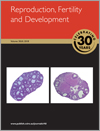Reproduction, Fertility and Development
Volume 30
Number 4 2018
Adiponectin may be a potent therapeutic agent for recovery of the polycystic ovary syndrome (PCOS) condition. The aim of the present study was to unravel the role of adiponectin in regulating reproduction, metabolism and fertility status in mice in which PCOS had been induced. Reversal of PCOS-like features following adiponectin treatment in mice is a major breakthrough with regard to the effective management of PCOS.
Milk fat globule-EGF factor 8 protein (MFGE8) is a protein that promotes cell to cell adhesion and is thought to play an essential role in embryo implantation in mice and humans. We have described the expression of MFGE8 in the equine uterus and found particular strong expression of the protein by the fetal portion of the placenta. These results imply a role for MFGE8 in maintaining an intact placenta during mare pregnancy.
During cryopreservation, spermatozoa undergo cryodamage because of membrane changes, including sterol loss, which results in diminished post-thaw fertilisation ability. The present study showed that loading of cholesterol and desmosterol into chicken spermatozoa prior to cryopreservation enhanced their post-thaw quality by inhibiting apoptotic changes and premature acrosome reaction, providing new mechanistic insight into cryodamage in chicken spermatozoa.
Uncontrolled inflammation of the oviduct can result in tubal occlusion and infertility. This inflammation is often in response to infection with sexually transmitted bacterial pathogens. This study describes how the endotoxin from Escherichia coli-derived lipopolysaccharide affects the expression of inflammatory mRNAs and post-transcriptionally modifying miRNAs within the oviduct, providing novel insight into the molecular regulation of inflammation within this key reproductive organ.
Kisspeptin peptide is a major regulator of initiation of pubertal actions in the central nervous system, but its development in growing animals is obscure. The presence of kisspeptin neurons in the brain from birth to puberty in relation to luteinising hormone release pattern was analysed in female lambs. Activity of kisspeptin neurons increased gradually parallel with augmentation of luteinising hormone release and reached maturation several weeks before puberty. The participation of kisspeptin in the development of the ovine reproductive processes is suggested.
To improve current infertility treatments, it is necessary to evaluate uterine receptivity in each menstrual cycle. If this can be evaluated beforehand, when uterine receptivity is inadequate eggs could be stored using cryopreservation. In this study in a mouse model, we identified an electrophysiological parameter that can evaluate uterine receptivity prospectively.
Signalling pathways responsible for follicular activation in the mare remain uncharacterised. Messenger RNA expression and protein localisation of members of the PI3K/AKT and JAK/STAT pathways were analysed using tissue from fetal and adult mare ovaries. Findings suggest that members of these pathways are indeed present and may serve as useful biomarkers for assessment of ovary development in the horse.
The forkhead box (Fox) gene family encodes multiple forkhead proteins that exhibit marked functional diversity and are involved in biological processes, especially sex differentiation. The identification, characterisation, selective pressure, protein structure and expression pattern of Fox genes in response to temperature were investigated in the present study in the Chinese giant salamander Andrias davidianus to enrich the sexual development and reproduction mechanism in amphibian.
The role of melatonin as an endocrine regulator of reproductive activity is well known; however, whether it stimulates or inhibits reproductive function varies across species. We demonstrated that in vitro exposure to melatonin reduced steroid production by ovarian theca cells in cattle, implicating melatonin as a regulator of reproductive function in cattle. Because reduced reproductive capacity leads to economic losses, an understanding of the effects of melatonin on ovarian function may lead to new ways to increase reproductive efficiency in cattle.
Angiogenesis is a vital process in the development and survival of lesions during endometriosis. In the present study we identified upregulation of several isoforms of vascular endothelial growth factor (VEGF) A in the endometrium of women with endometriosis during menstruation and, for the first time, identified the natural expression of the VEGF111 isoform in humans. These findings contribute to our understanding of how the endometrium differs in women with endometriosis, and indicates a dysregulation at the critical time of menstruation.
Do extracellular vesicles have a biological role in the communication between the embryo and its microenvironment during in vitro culture? In this study we showed that embryos were able to incorporate microvesicles obtained from endometrium and amnion, but only amniotic progenitor cell-derived microvesicles resulted in better blastocyst production rate and quality compared to control. This study could be a useful starting point for further studies related to paracrine mechanisms of communication between embryos and the culture medium.
This research provides new insight into central molecular mechanisms regulating GnRH/LH secretion in anestrous sheep. To better explain this problem, herein, we demonstrated that RF-amide peptides are involved in dopamine-induced inhibition of GnRH/LH secretion. Studies expanded an important issue in the field of neuroendocrinology of reproduction, especially in cognitive appraisals of mechanisms participating in physiological regulation of GnRH/LH biosynthesis.




